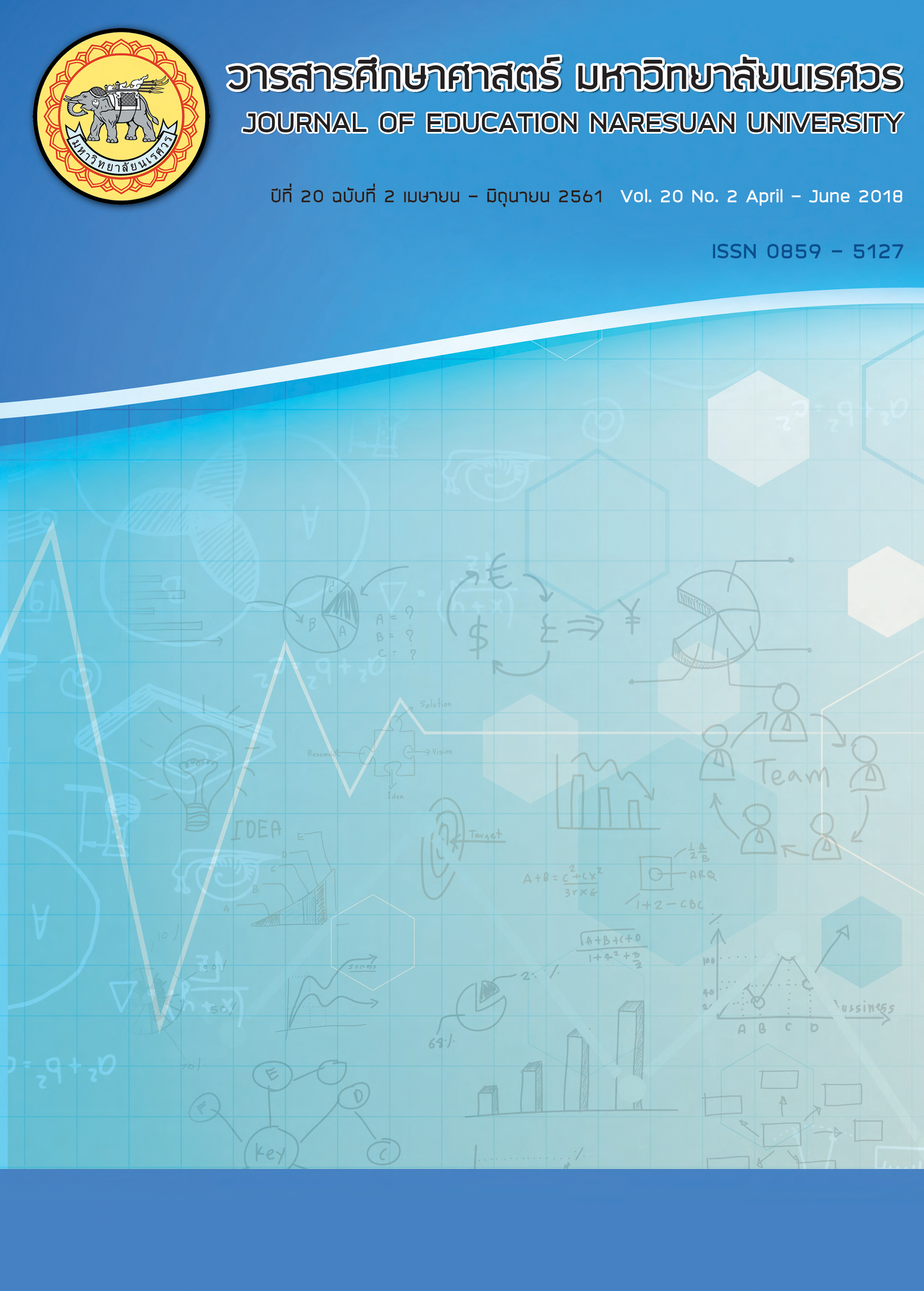การวิจัยปฏิบัติการเพื่อพัฒนาการจัดการเรียนรู้ เรื่อง ปริมาณสารสัมพันธ์ ตามแนวสะเต็มศึกษาที่เน้นกระบวนการออกแบบเชิงวิศวกรรม ที่ส่งเสริมสมรรถนะการแก้ปัญหาแบบร่วมมือ; THE ACTION RESEARCH FOR DEVELOPING LEARNING MANAGEMENT ON STOICHIOMETRY BASED ON STEM...
Main Article Content
Abstract
งานวิจัยเชิงคุณภาพนี้ มีจุดมุ่งหมายเพื่อศึกษาวิธีการจัดการเรียนรู้ตามแนวสะเต็มศึกษาที่ส่งเสริมสมรรถนะการแก้ปัญหาแบบร่วมมือและผลการจัดการเรียนรู้ที่มีต่อการส่งเสริมสมรรถนะ รูปแบบการวิจัยเป็นวิจัยปฏิบัติการ ประกอบด้วย ขั้นวางแผน ขั้นปฏิบัติ ขั้นสังเกต และขั้นสะท้อนผล ดำเนินเป็นวงจรต่อเนื่องกัน 3 วงจรปฏิบัติการ ผู้เข้าร่วมวิจัย เป็นนักเรียนชั้นมัธยมศึกษาปีที่ 4 จำนวน 21 คน ได้มาจากการเลือกแบบเจาะจง เครื่องมือวิจัย ได้แก่ แผนการจัดการเรียนรู้ แบบบันทึกสะท้อนผล แบบทดสอบ และบันทึกประจำวัน และวิเคราะห์ข้อมูลโดยใช้การวิเคราะห์เนื้อหา และตรวจสอบข้อมูลแบบสามเส้า ผลการวิจัยพบว่า การจัดการเรียนรู้ควรประกอบด้วย 10 ขั้นตอน ได้แก่ 1) ขั้นตรวจสอบมโนทัศน์พื้นฐาน 2) ขั้นระบุปัญหา 3) ขั้นศึกษาปัญหา 4) ขั้นพัฒนาวิธีแก้ปัญหาที่เป็นไปได้ 5) ขั้นเลือกวิธีแก้ปัญหาที่ดีที่สุด 6) ขั้นสร้างชิ้นงาน 7) ขั้นทดสอบและประเมินวิธีแก้ปัญหา/ชิ้นงาน 8) ขั้นนำเสนอวิธีแก้ปัญหา 9) ขั้นปรับปรุงแก้ไข และ 10) ขั้นการสรุปและประเมินผล ซึ่งช่วยให้ นักเรียนส่วนใหญ่มีสมรรถนะการแก้ปัญหาแบบร่วมมืออยู่ในระดับกลาง ทั้งนี้ นักเรียนไม่สามารถระบุเงื่อนไงและข้อจำกัดของปัญหาและไม่สามารถรับมือกับความขัดแย้งที่เกิดจากการทำงานร่วมกันได้ ดังนั้น การจัดการเรียนรู้ควรส่งเสริมให้มีการนำเสนอข้อมูลเชิงหลักการสนับสนุนวิธีแก้ปัญหาของนักเรียนมากขึ้น และให้ความสำคัญกับบทบาทของสมาชิกกลุ่มแต่ละคนได้มีส่วนร่วม ตลอดจนการสร้างความตระหนักถึงความสำคัญของสมาชิกและการยอมรับซึ่งกันและกันให้มากขึ้น
THE ACTION RESEARCH FOR DEVELOPING LEARNING MANAGEMENT ON STOICHIOMETRY BASED ON STEM APPROACH EMPHASIZED ENGINEERING DESIGN PROCESS TO PROMOTE COLLABORATIVE PROBLEM SOLVING COMPETENCY
This qualitative research aims to develop the STEM approach based on engineering design process to enhance the collaborative problem solving competency (CPS) and the effect of teaching approach to promote CPS. The research methodology was the action research consisting of Plan, Action, Observe and Reflect, which proceeded continue in 3 cycles. The participants were 21 students of grade 10th with purposive sampling. Research instruments included 3 lesson plans, CPS test, Research journal and Reflect journal. Data analysis by content analysis and data creditability by triangulation method were used. The result reveal that the STEM approach consist of 10 steps included 1) Pre-concept investigation, 2) Identify need or problem, 3) Research need or problem, 4) Develop possible solution, 5) Select the best solution, 6) Construct a prototype, 7) Test and evaluate the solution, 8) Communicate the solution, 9) Redesign, and 10) conclusion and evaluation step. Furthermore, the result indicated that most students had a middle level of competency. Students could not identify the criteria and constraints of the problems. In addition, they could not handle with conflict, which happened when working together. Therefore, in the learning management should encourage the students have to present more theoretical data to support their solutions. Besides, to focus on the role of each member is importance. So, they would perform their own duties and more contribute along with raising awareness of more mutual acceptance.
Article Details
The owner of the article does not copy or violate any of its copyright. If any copyright infringement occurs or prosecution, in any case, the Editorial Board is not involved in all the rights to the owner of the article to be performed.
References
BouJaoude, S., & Barakat, H. (2003). Students’ Problem Solving in Stoichiometry and the Relationships to Conceptual Understanding and Learning Approaches. Electronic Journal of Science Education, 7(3), 1-42.
Bridges, C. D. (2015). Experiences Teaching Stoichiometry to Students in Grade 10 and 11. (Doctoral dissertation). Maryland: Walden University.
Brophy, S., Klein, S., Portsmore, M., & Rogers, C. (2008). Advancing Engineering Education in P-12 Classrooms. Journal of Engineering Education, 97(3), 369 – 387.
Faikhamta, C. (2016). Action research in science classroom. Bangkok: Institute of Academic Development. (in Thai)
Gauvain, M., & Cole, M. (1997). Reading on the development of children. Retrieve April 15, 2016, from https://www.psy.cmu.edu/~siegler/vygotsky78.pdf
Householder, D. L., & Hailey, C. E. (2012). Incorporating engineering design challenges into STEM Courses. Retrieve April 28, 2016, from https://digitalcommons.usu.edu/ncete_publications/166
Institute for the Promotion of Teaching Science and Technology. (2014). Chemistry 2 (6th ed.). Bangkok: Kurusapa Printing Ladphrao. (in Thai)
Institute for the Promotion of Teaching Science and Technology. (2014). The result of PISA 2012: reading literacy, mathematical literacy and scientific literacy. Bangkok: Aroon Printing. (in Thai)
Kapur, M., & Toh, P. L. L. (2013). Productive failure: From an experimental effect to a learning design. Educational design research – Part B: Illustrative cases, 341 – 355.
Khammani, T. (2014). Pedagogy: knowledge for effective learning processes (18th ed.). Bangkok: Chulalongkorn University. (in Thai)
Kijkuakul, S. (2015). STEM Education (Part II): How to integrate STEM Education in classroom teaching. Journal of Education Naresuan University, 17(3), 154 – 160. (in Thai)
Kijkuakul, S. (2014). Scientific learning management: The guide for teachers in 21st century. Petchaboon: Chunladit printing Press. (in Thai)
Lou, S., Shih, R., Diez, C. R., & Tseng, K. (2010). The Impact of Problem-Based Learning Strategies on STEM Knowledge Integration and Attitudes: an Exploratory Study among Female Taiwanese Senior High School Students. International Journal of Technology & Design Education, 21, 195 – 215.
Morgan, J. R., Capraro, M. M., & Capraro, R. M. (2013). STEM Project-based Learning: An Integrated Science, Technology, Engineering, and Mathematics (STEM) Approach. Rotterdam: Sense Publishers.
OECD. (2013). PISA 2015 Draft Collaborative Problem Solving Framework. Paris: OECD.
Shieh, R. S., & Chang, W. (2014). Fostering Student’s Creative and Problem-Solving Skills through a Hands-On Activity. Journal of Baltic Science Education, 13(5), 650 – 661.
Siripatharachai, P. (2013). STEM Education and 21st Century Skills Development. Executive Journal, 33(2), 49-56. (in Thai)
Strimel, G. (2014). Shale Gas Extraction: Drilling into Current Issues and Making STEM Connections. Resources in Technology and Engineering, 16 – 24.
Wongwanich, S. (2014). Classroom action research (17th ed.). Bangkok: Chulalongkorn University Press. (in Thai)


